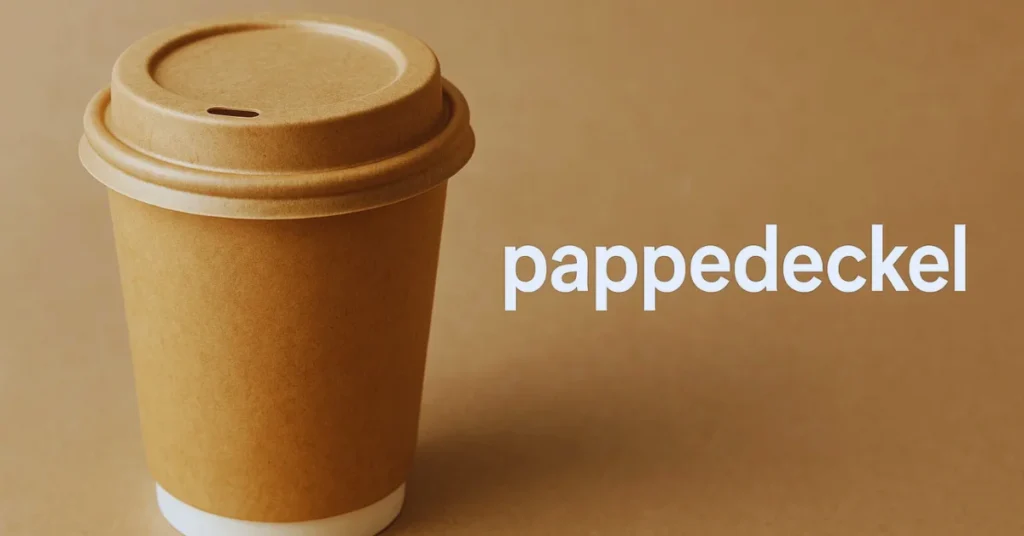Pappedeckel: Uses, Benefits, and Role in Sustainable Packaging
The term “Pappedeckel” refers to a cardboard lid commonly used in packaging, especially for food and beverages. Originating from the German words Pappe (cardboard) and Deckel (lid), it has become an essential component in modern eco-friendly packaging solutions. As businesses and consumers move toward sustainable choices, the Pappedeckel has gained popularity as a biodegradable alternative to plastic lids. This article explores its materials, manufacturing, types, benefits, challenges, and future in the packaging industry.
Materials Used in Making Pappedeckel
Pappedeckel lids are typically made from high-quality cardboard, often sourced from recycled paper. Manufacturers use several types of cardboard, including:
- Kraft paperboard – strong, durable, and naturally brown
- Coated paperboard – treated for water and moisture resistance
- Recycled cardboard – sustainable and widely available
These materials ensure the lid is sturdy enough for practical use while remaining eco-friendly. Many companies now prefer FSC-certified paper, guaranteeing responsible forest management. The shift to recyclable and compostable materials makes Pappedeckel ideal for businesses looking to reduce their environmental footprint.
Manufacturing Process of Pappedeckel
Producing Pappedeckel involves a detailed and efficient manufacturing process:
- Raw Material Selection: Cardboard sheets are chosen based on thickness and required durability.
- Cutting: Machines cut the sheets into pre-designed shapes.
- Forming: The cut pieces are molded using pressure and heat to achieve a lid shape that fits cups or containers.
- Coating (optional): Some lids are coated with biodegradable waterproof layers.
- Branding: Printing machines apply logos, colors, or text directly onto the surface.
- Quality Check: Completed lids are inspected for shape, durability, and moisture resistance.
Modern machinery allows bulk production with minimal waste, making Pappedeckel a cost-effective and scalable solution.
Different Types of Pappedeckel
Depending on the purpose, Pappedeckel is available in several forms:
1. Coffee Cup Lids
Designed for hot beverages, these lids help maintain heat and prevent spills. They are common in cafes and takeaway shops.
2. Food Container Covers
Used for bowls, trays, and meal boxes, these cardboard lids keep food fresh without needing plastic.
3. Custom-Designed Cardboard Lids
Businesses often order unique shapes and designs for brand recognition or to fit specialized containers.
Environmental Benefits
One of the strongest advantages of Pappedeckel is its eco-friendly nature. Unlike plastic lids that take centuries to decompose, cardboard lids break down naturally within months. Their benefits include:
- Biodegradability: Cardboard decomposes quickly without harming the environment.
- Recyclability: Almost all Pappedeckel products can be recycled through standard paper waste systems.
- Reduced Plastic Waste: Replacing plastic lids with cardboard significantly lowers pollution.
- Lower Carbon Footprint: Production of cardboard uses less energy and emits fewer greenhouse gases compared to plastic manufacturing.
This makes Pappedeckel a preferred choice for environmentally responsible consumers and businesses.
Uses of Pappedeckel in Daily Life
Pappedeckel is widely used across various industries:
- Cafes and Restaurants: For coffee cups, dessert cups, and meal boxes.
- Takeaway and Food Delivery: Helps maintain food quality while offering eco-friendly packaging.
- Events and Catering: Disposable yet sustainable options for large-scale food service.
- Eco-friendly Brand Packaging: Many brands use cardboard lids to promote sustainable values.
The wide range of uses makes Pappedeckel a versatile and practical packaging solution.
Pappedeckel in the Packaging Industry
The packaging industry is undergoing a major shift toward sustainable materials. Pappedeckel plays a key role in this transition due to:
- Cost-effectiveness compared to plastic alternatives
- Customizability for different businesses and branding needs
- Compatibility with biodegradable and compostable packaging systems
Companies aiming to build an eco-conscious image prefer Pappedeckel as it aligns with consumer expectations for green solutions.
Customization and Branding Options
One major advantage of Pappedeckel is its ability to be customized. Businesses can print:
- Logos
- Slogans
- Colorful designs
- QR codes
- Marketing messages
These designs enhance brand recognition, making Pappedeckel not just functional but a powerful marketing tool. Custom lids also help brands stand out in competitive markets like cafes and restaurants.
Comparison: Pappedeckel vs. Plastic Lids
| Feature | Pappedeckel | Plastic Lids |
| Eco-friendliness | Highly sustainable | Non-biodegradable |
| Recyclability | Easy to recycle | Difficult & limited recycling |
| Durability | Good, but less water-resistant | Highly durable |
| Cost | Often lower or similar | Varies, sometimes higher |
| Environmental Impact | Very low | High pollution & waste |
While plastic may offer superior water resistance, Pappedeckel wins in sustainability, recyclability, and environmental safety.
Also Read: Vitilinox Cream Review: How It Helps Treat Vitiligo Naturally
Challenges and Limitations
Although Pappedeckel has many advantages, it also comes with a few limitations:
- Moisture Sensitivity: Without coating, cardboard may weaken when exposed to liquids.
- Durability: Not as strong as hard plastic under heavy pressure.
- Availability: High demand for sustainable products can sometimes limit supply.
- Cost Variation: Eco-friendly coatings or premium printing may increase the price.
However, ongoing innovations in the packaging industry are addressing most of these challenges.
Future of Pappedeckel in Sustainable Packaging
The future of Pappedeckel looks promising. With increasing global awareness of plastic pollution and government regulations encouraging paper-based packaging, demand is expected to rise significantly. Innovations include:
- Improved waterproof biodegradable coatings
- Stronger and lighter cardboard materials
- 100% compostable packaging solutions
- Smart printing technologies for branding
As businesses shift toward environmentally friendly practices, Pappedeckel will continue to grow in importance.
Conclusion
Pappedeckel has emerged as a practical, sustainable, and cost-effective alternative to plastic lids. Made from recyclable materials and widely customizable, it supports global efforts to reduce waste and promote eco-friendly packaging. Despite some limitations, ongoing advancements are strengthening its role across industries. As consumers and companies embrace greener choices, Pappedeckel will remain a key component of sustainable packaging in the future.



